The United States of America is Becoming a Failed State

President Donald Trump (photo: Joyce N. Boghosian/White House)
In January 2018, President Trump disparaged African countries and Haiti by referring to them as “s---hole” countries. He asked why the United States would want more immigrants from these debilitated economies. Given the president’s comments, there is some amount of irony in the fact that the United States appears to be on track to join the same list of countries that he referred to. As a tweet by Jasmine Tyon aptly described it, the U.S. is a third-world country with a Gucci belt. You may not see it yet, but it is quickly becoming a failed state.
Additionally, sentiments expressed by the president notwithstanding, our country isn’t heading towards failed statehood because it allowed entry to immigrants from under developed nations.
Some would argue that race -- in terms of Trump, racism and white supremacy -- has a lot to do with the United States’ march toward failed statehood. The fact remains that immigrants from under-developed nations have little to do with the failure that Trump has led this country to.
There are a number of factors that precede failed statehood. My focus here is accountability — in this case, the lack of it.
A failed state is a country with a political economy that has become so dysfunctional that it can no longer function properly. Even if it appears to display functionality, it is not considered legitimate, and that is precisely what is happening to the United States.
The federal government has many parts to play, but of the responsibilities entrusted to it, the two most essential are both intricately linked to accountability.
The first responsibility is to ensure appropriate segregation of powers so that we don’t end up with a King (having a Queen is unlikely, since as an enlightened, first-world country, the U.S. is still a long way from electing a female president). Even at this point we find ourselves under President Trump, we are unlikely to end up with a King because one cannot be a King while simultaneously abdicating accountability. We currently do not have a King, a Queen, or even, really, a President.
What we have is an aspiring despot — a ruler whose wish is mostly Congress’ command; a tyrannical, oppressive autocrat.
The second most central responsibility of the federal government is to ensure that the rights of U.S. citizens and, yes, undocumented persons alike, remain protected. How protected do you feel these days?
So what is accountability? It’s rooted in one’s obligation or willingness to accept responsibility for their actions. Notice willingness. If a person does not deem something as their responsibility, then they cannot be held accountable. To deny responsibility and accountability can thus quickly translate into a perpetual state of denial, and that is precisely what our president does.
Trump denies the role he has played in leading one of the world’s superpowers to imminent disaster. From the Mueller findings on obstruction to the impeachment offenses to personally benefiting financially from his government position to introducing his Muslim travel ban and creating racial unrest to the ill-equipped and deadly responses to Hurricane Maria and the COVID-19 pandemic, the list of Trump’s failures is impossibly long and, thus far, with zero accountability attached to it.
In the case of failed states, the ineffective organization of political communities permits powerful individuals to skirt their duties and avoid accountability. That’s what is happening to the United States. American politics has become entrenched in tribalism and sectionalism. This has played an essential role in shaping the United States into a failed state. Individuals are no longer restrained by notions of basic morality. Cruelty gets normalized and combatants become increasingly inclined toward corruption. If this continues, the U.S., I advance, will finally be declared the failed state that our president wants it to be, so he can consolidate power to himself.
It’s not too late, though. We are still a democracy. As people, we have the power to elect our next leader. If we don’t vote to install a new government that respects the appropriate segregation of powers and works to ensure that the rights of U.S. citizens and undocumented persons are protected, then we are equally accountable for what happens next.
Come the fall election, you can either shun your responsibility or accept it as an obligation to your country. If we act decisively, we may still be able to reverse our rapid transition to failed statehood and begin to rebuild this country.
***
Lessie Branch is an Associate Professor at Metropolitan College of New York; author of Optimism At All Costs: Black Attitudes, Activism, and Advancement in Obama’s America; and co-host of HERe ME Podcast. On Twitter @LessieBBranch.
***
Have an op-ed idea or submission for Gotham Gazette? Email This email address is being protected from spambots. You need JavaScript enabled to view it.
The Bronx to SoHo: Pull Your Weight in Addressing the City's Housing and Segregation Crises
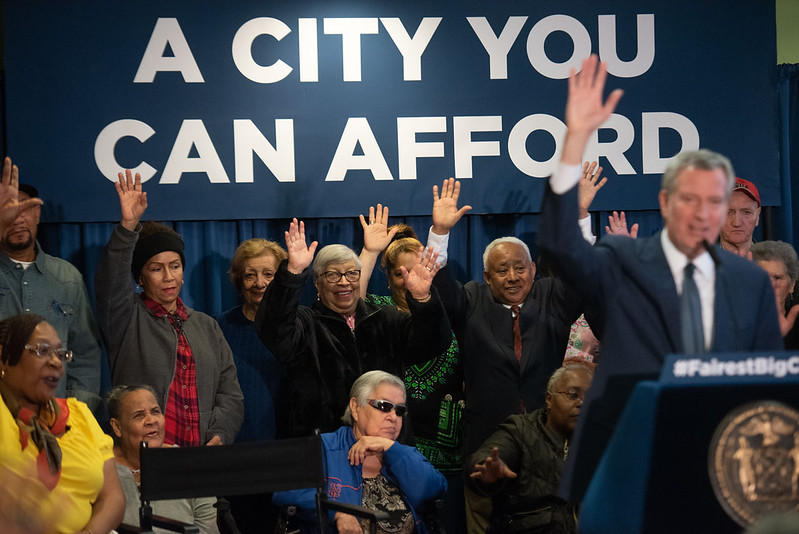
Mayor de Blasio with New Yorkers (photo: Michael Appleton/Mayor's Office)
Dear Mayor de Blasio, Manhattan Borough President Brewer, Council Member Chin, and Members and Residents of Manhattan Community Board 2:
My name is John Sanchez, I’m the District Manager of Bronx Community Board 6, a great neighborhood, but also among the poorest in our city. In Bronx CB6, which includes Belmont, East Tremont, and West Farms, there is a 31% poverty rate, a higher than 30% unemployment rate, and 60% of residents are rent-burdened. I love my neighborhood but I can’t fault any of my neighbors for wanting to live in a higher opportunity neighborhood like SoHo or The Village in Manhattan Community Board 2, especially given it would likely help their children’s long-term outcomes for career earnings, health, and educational attainment.
While I am sure many residents in places like Manhattan CB2 finally recognize that Black Lives Matter, in too many parts of our city this call to action stops when it comes to integrating exclusionary neighborhoods and having Black neighbors. I am writing to implore you to take a monumental first step toward equitable integration by supporting the plan presented by Open New York to rezone SoHo and NoHo for thousands of new homes, of which at least 700 would be deeply affordable through the Mandatory Inclusionary Housing (MIH) program.
The rationing of affordable housing development in New York City due to arbitrary zoning rules and local control and the resulting displacement of demand to communities like mine must end.
I actually used to live in SoHo when I was a Resident Assistant at NYU. While the odds of attending NYU as a Black and Latino man from The Bronx are slim but improving, the odds of someone like me building a life in SoHo are six times lower, with only 2% of Manhattan CB2 residents being Black. The neighborhood’s long-standing refusal to construct affordable housing is the main reason for its lack of diversity. While neighborhoods such as Jerome Avenue, Far Rockaway, and East New York have been rezoned during the de Blasio administration, places like SoHo and Riverdale retain their zoning from nearly 40 years ago, limiting the number of people who can live there and preserving their pale “community fabric” instead of fostering beautiful mosaics.
Adding insult to injury, our city’s inequitable land use strategy contradicts the Department of Housing Preservation and Development’s very own guidance, which states “MIH requirements work best in strong housing markets. Rental projects in moderate and weak markets do not achieve sufficient returns to achieve feasibility without subsidies.” Allowing the stronger housing markets like SoHo to build without subsidies would allow low-income areas like my community board to have more subsidy dollars to build more units of housing at deeper levels of affordability.
The fiscal crisis brought on by the pandemic makes changing this dynamic even more urgent - if the city is going to cut $1 billion from our affordable housing construction budget, we must get the most equitable bang for our buck with the funding that’s available.
The pandemic has shown us that viruses don’t recognize the geographic lines that define our land use process. New York is an interconnected city that cannot exist without people of all backgrounds doing their part, especially when it comes to addressing our affordable housing crisis. Whether operating our transportation system, staffing our hospitals, teaching our children, delivering our food, or cleaning our streets, our city would grind to a halt without the essential workers who mostly live in communities like mine. Yet in wealthy neighborhoods like SoHo they’re only welcome to visit when working, shopping, or sight-seeing, but not if they’re looking for a place to live.
If you can accept a food delivery from a New Yorker who doesn’t look like you, you can also embrace them as a neighbor. If you can hire a nanny for your children who looks different from you, you can also embrace their children as classmates of your own children.
Upzoning SoHo for mixed-income housing would be an important next step in building a New York that is united and open to all regardless of background or income. Let’s show the whole city that building more housing is not a burden on any community, but a benefit for us all that should happen throughout the five boroughs.
***
John Sanchez is the District Manager of Bronx Community Board 6 and a candidate for City Council in District 15. On Twitter @NYJohnSanchez.
***
Have an op-ed idea or submission for Gotham Gazette? Email This email address is being protected from spambots. You need JavaScript enabled to view it.
Efforts to End Racism Must Include Dismantling Housing Discrimination
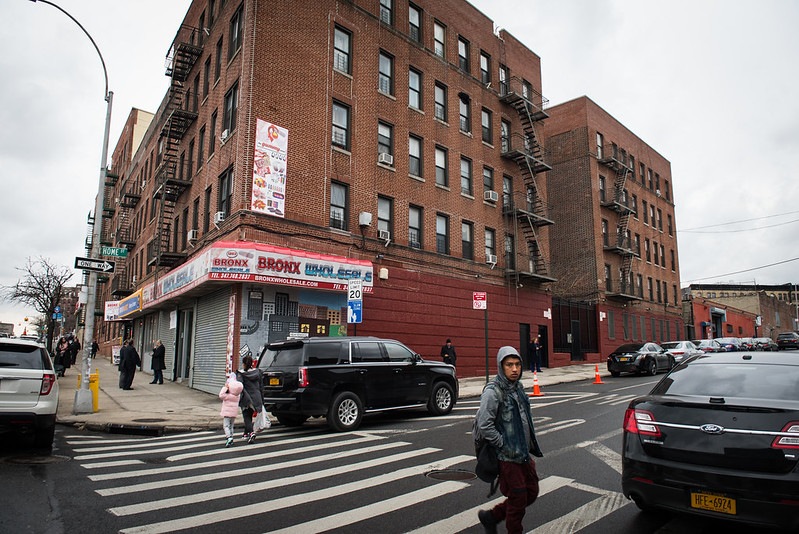
Housing discrimination must be addressed (photo: Edwin J. Torres/Mayor's Office)
In January 2015, I was released from a federal prison in California with the clothes I came in with, a few personal possessions I’d collected over the six years I had been incarcerated, and a bus ticket back to New York City. After a six-day journey home, I found myself subletting a room from a family friend – and as long as the rent was paid on time, they did not ask questions. Living in this apartment allowed me to find employment, cultivate relationships with my family, and continue pursuing my degree at City Tech. Unfortunately, this arrangement did not last.
In 2017, the landlord conducted a criminal background check and proceeded to evict me. Within a few months, I was in a homeless shelter.
Communities of color are disparately harmed by so many systems – particularly the intersection of our criminal legal system and our housing system. As a person of color in America, I am constantly straddling those two systems and the racist laws that sustain them. The incredible protests sweeping across all 50 states (and several countries) are demanding accountability to Black and brown lives — investing away from police and toward structural change. But this change can’t begin and end with police reform. It must also extend to all other systems, especially housing.
After my eviction, I worked tirelessly to find a new home. I called real estate agents, filled out applications, paid for nonrefundable background checks (between $25 and $50 each), put down deposits, and met with landlords. When faced with the question, “Where have you lived for the past five years?” or “Have you ever been convicted of a crime?” I answered honestly: “prison” and “yes.” On paper, I had not existed until my release from prison. Between this and background checks that confirmed my history, prospective landlords deemed me unworthy of safe, stable housing.
My only options were overcrowded, vermin-riddled three-quarter houses, the city’s homeless shelter system, or living on the streets.
For three years now, I’ve been homeless – bouncing between shelters and temporary arrangements with friends and family. Currently, I share a cramped room with my nephew. The apartment is next to a highway and my window looks out onto a cemetery.
Unfortunately, my situation is not an anomaly. Housing options for people with conviction records are slim. The New York City Housing Authority (NYCHA) would be a reasonable option, but NYCHA can exclude system-impacted people from applying, living, or even visiting family and friends in NYCHA housing. In short, people with records are systematically excluded from both private and public housing.
It astounds me that these discriminatory policies persist, especially when research consistently shows that stable housing promotes successful reentry and reduces recidivism. Having a place to call home enables formerly incarcerated people to gain and retain employment, connect with family, and avoid future entanglements with the criminal legal system – all of which contribute to creating safer communities for everyone.
Legislation can fix this problem by prohibiting housing discrimination based on conviction records. Passing such a law will prevent real estate brokers and landlords from refusing to sell, rent, or lease housing to people based on past conviction records. It would mean people like me could finally have a place to call home.
New York has the second-highest rate of homelessness in the United States: roughly 80,000 people in the City do not have a place to call home and are in shelter; tens of thousands more are living in informal arrangements like doubling up with friends or relatives. Research shows that roughly 15% of all incarcerated people experience homelessness in the year prior to admission to prison.
Upon release, formerly-incarcerated people are seven times more likely to be homeless than someone without a history of system-involvement. In 2017, 54% of those released from prisons in the state wound up in a homeless shelter in New York City.
But this is not just a homelessness issue – this is a racism issue. Our mass policing, arrest, and incarceration policies disproportionately target communities of color. As a result, one in three Black adult men has a felony conviction in the United States. The racial disparities in incarceration are particularly stark in New York City, where 90 percent of people in jail are Black or Hispanic.
Every one of those people faces housing discrimination and a hard road back.
When I was released from prison in 2015, I incorrectly assumed that I had paid my debt to society and that I could become a productive, contributing member of my community. Instead, I continue to suffer from the collateral consequences of both a racist criminal legal system and deeply entrenched racism in our housing laws.
A conviction history should be a history – not a life sentence. If we truly want to create lasting changes to our racist laws and systems, we must end racist discrimination in housing once and for all.
***
Devone Nash is a mental health advocate and member of the Fair Chance for Housing Coalition. He lives in New York City and recently graduated from Medgar Evers College with a degree in Psychology.
***
Have an op-ed idea or submission for Gotham Gazette? Email This email address is being protected from spambots. You need JavaScript enabled to view it.
Now More Than Ever, New York City Needs Leaders to Welcome Jobs
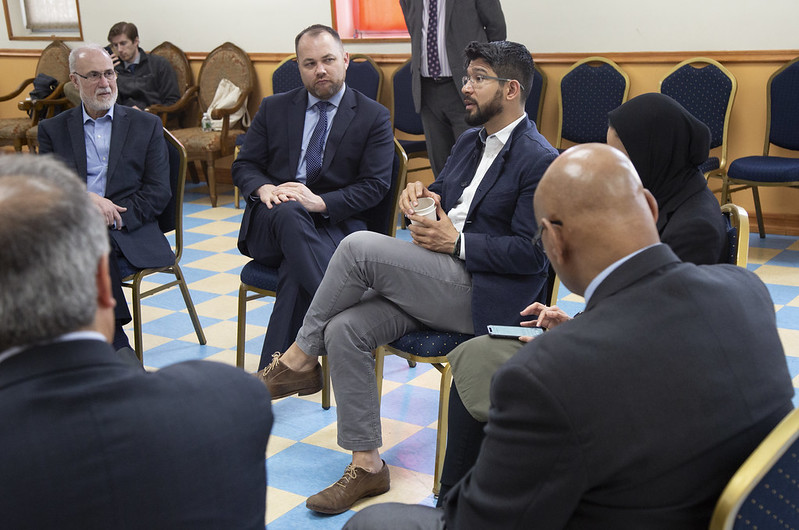
Council Member Menchaca & Speaker Johnson (photo: John McCarten/City Council)
All of us who care about New York City – and if you are a regular reader of Gotham Gazette that surely includes you – are worried about its future. COVID-19 has shuttered our economy and seriously impaired the lives and livelihoods of millions of our residents. It is clear that things will never go back to the way they were and that we must turn this disaster into an opportunity to bring back a different, better, fairer city.
But fear of change and the demonizing of ‘development’ risk derailing one of the most important vehicles New York has to generate new jobs and revenue: changes in zoning so that neighborhoods can adjust to new conditions and attract more housing and business. In January I wrote about the risk to the city’s plan to upzone Inwood in Northern Manhattan to provide more housing. Though the plan included a number of community enhancements and had been approved by the area’s City Council member, Ydanis Rodriguez, it was challenged in court by local opposition groups. Fortunately the appellate division correctly reversed the lower court’s decision, but the opposing groups have vowed to appeal.
Now comes another possible derailment of a proposed zoning change: the rejection by Council Member Carlos Menchaca of the proposal to expand Industry City on the Brooklyn waterfront. This plan to turn the area around the vibrantly successful and creative Industry City into a light manufacturing zone was first announced in 2015 and has been reviewed and refined in response to community input. The developers have indicated willingness to sign a community benefits agreement including all of the requirements Menchaca had specified, including removal of hotels from the plan, restriction on the amount of retail space, creation of a manufacturing hub managed by a non-profit, expansion of the existing Innovation Hub to connect more local residents to jobs, support for worker cooperatives and training and research around green manufacturing.
In both the Inwood and the Industry City cases, despite years of community engagement and input, whether through ‘member deference’ which enables the local Council member to veto a project or, failing that, through the courts, vocal groups have been able to sidetrack the projects. The chilling effect of the failure to bring an Amazon headquarters to Queens is being exacerbated just at the moment when we need to be encouraging outer-borough centers of innovation and employment.
Of course every effort should be made to assure that the current residents of the surrounding area benefit from new development, and the Industry City plan adopts this goal. Indeed 57% of the 8,000 jobs already created by Industry City are filled by Brooklyn residents and 37% from the immediate neighborhood. This rezoning would bring an additional $64 million in private investment on top of the $400 million already spent on Industry City revitalization. It would attract new kinds of businesses and pump 15,000 more jobs and $100 million a year in tax revenue into the city’s economy. Projects like this are vital to ensuring a healthy future and the stakes are too high to let a determined minority override the best interests of everyone else.
A few public officials have come forward to defend the Industry City project and urge its approval despite the local Council member’s objection. Two of them wrote convincingly in the Daily News, but they are from other boroughs and are moving on from the Council to other positions at the end of the year. Closer to home, Brooklyn Council Member Robert Cornegy Jr. courageously wrote to his colleagues in the Brooklyn delegation urging them to join him in supporting the Industry City zoning application notwithstanding their colleague’s objections. In a follow up op-ed in the Brooklyn Eagle he summed up the argument:
“In the pre-pandemic world, this was already a precedent-setting example of responsible development in our borough that would have been an important project for Brooklyn’s economic future. Now, in the face of a financial crisis unlike anything since the Great Depression, it is an absolute necessity."
"We find ourselves at a historically precarious junction and it is not an exaggeration to suggest that the City Council is now faced with a decision that will help to determine which economic path our City ultimately takes…This pandemic has forced us to think anew about what’s best for the greater good of our borough, our city and all of our residents – not just those within a few square blocks of a proposed development – and within that context I believe the choice for the City Council on Industry City’s proposal should be clear.”
Bravo! Now what is needed is leadership from city-wide officials who are willing to step up and represent the needs and interests of the entire city. So amid mass unemployment in our city, what does Mayor de Blasio have to say? When first asked about it, he said that because it is a private application his administration doesn’t play a “leading role” and that while jobs are welcomed in New York City, it is really between the developer and the City Council.
The zoning process is overseen by the City Planning Commission, a mayoral agency, which plays a leading role in all of these decisions. The fact that no public subsidies are required for the Industry City project is a plus, not an element that makes it a “private application” that is solely between the developer and the Council. For the mayor to take the position that he has no role in this or any large-scale land-use application unless his administration is the main driving force would be quite an abdication of responsibility.
It seems that he (perhaps urged by someone in his administration) thought it might be better to be slightly more engaged, and a few days later the mayor modified his comments when asked about Industry City again. The traditional deference to the impacted area’s Council member is worth respecting, he said, but added:
“But I do think we have to think about some of the overwhelming dynamics we're dealing with right now. We're in the middle of a pandemic and we've got to get people back to work. We've got to find every way to get livelihoods back to people who need them. So, that needs to be taken into account.”
This is not exactly a ringing endorsement of the Industry City plan, but it is an acknowledgement that the covid crisis should cause City Council members and many others to rethink their priorities and approach to growth, especially jobs. Approving this particular rezoning is the right thing to do and would also serve as a symbol that our elected leaders get that special, hard times call for new approaches. With New York City facing an economic abyss, the mayor has to ratchet up his support and work with the City Council to get the Industry City rezoning over the finish line.
That said, Mr. City Council Speaker, the ball is in your court.
***
Carol Kellermann was president of Citizens Budget Commission from 2008 through 2018.
***
Have an op-ed idea or submission for Gotham Gazette? Email This email address is being protected from spambots. You need JavaScript enabled to view it.
A Portal Does Not Replace A Knock On The Door
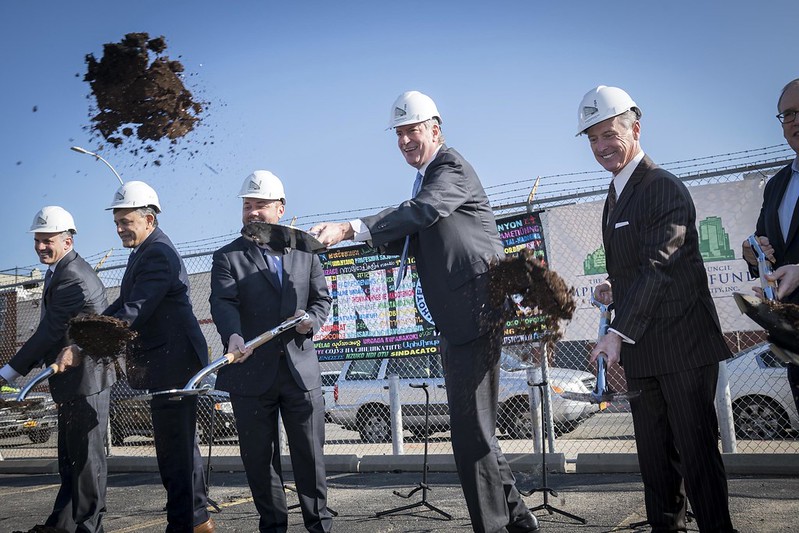
The mayor at a ground-breaking ceremony (photo: Ed Reed/Mayor's Office)
The Department of City Planning (DCP) has announced that it is resuming the city’s rezoning process after a five-month suspension due to the pandemic. But DCP has neither adapted the process that leads to significant land use changes to overcome the obstacles created by the pandemic nor the underlying structural racism embedded in land use decision-making. As DCP said in a recent statement reaffirming its commitment to dismantling institutionalized racism:
“We recognize that planning policies and zoning codes have acted for decades as bulwarks against fairness, inclusion and integration, and that they have played a large role in perpetuating racism and even violence against Black and Brown Americans…We are committed to unpacking and taking on institutionalized racism within the planning profession and examining our own role…”
If the city is to restart rezoning, it cannot be under the same structurally flawed process that it has acknowledged contributes to the disparities that have plagued this country since its inception. The current crisis of the COVID-19 pandemic as well as the ongoing protests for racial justice have further exposed the fatal impacts of institutionalized racism on Black and Latino communities. Resuming this flawed process while there are still pandemic-created obstacles to outreach, education, community organizing, and public participation will cause further harm to these communities.
Community groups that DCP relied upon for “getting out the word” are swamped with the need to feed and care for residents in their neighborhoods during this pandemic and the mass unemployment that has resulted from measures taken to contain COVID-19. The city’s creation of an online portal to provide information on attending virtual DCP meetings is not sufficient and will exclude hundreds of thousands of New Yorkers, many of whom are low income. A portal does not replace door-knocking.
Additionally, budgetary changes have greatly impacted how the city will be able to respond to demands for more affordable housing. Beginning a zoning change now that relies on the current Mandatory Inclusionary Housing (MIH) mechanism is extremely problematic and fundamentally unfair due to the draconian cuts to the city’s capital budget. The funding that would have been used to deepen affordability under MIH and provide additional services to remediate the negative impacts of a rezoning has evaporated.
There are gaping holes and misguided instructions in the City Environmental Quality Review (CEQR) manual for gathering the information that goes into environmental impact statements - information essential for community boards, the City Planning Commission, and the City Council to accurately and fairly assess a zoning change before they vote on major land use changes (see more here and here).
These flaws hide the displacement and inadequacy of any anticipated affordable housing, and do not project how a zoning change will alter the racial composition of a neighborhood such as when older buildings are torn down and replaced with new “luxury condos.” The CEQR guidelines assume that tenants in buildings with six or more units are protected by rent regulation even though those protections are frequently evaded. Evictions, already highest in Black and Latino communities, are expected to rise as a result of the pandemic.
The CEQR guidelines are completely silent on the financial impacts a rezoning has on property values - critical information that communities and elected officials need when they try to negotiate with developers for more and deeper affordable housing, schools, libraries, and other community benefits.
In addition to providing resources and information essential to a fair zoning process, DCP must be creative and innovative to overcome the obstacles to communications and outreach created by the pandemic, which still threatens people’s health and undermines the existing public engagement process.
The city cannot resume land use processes that will impact Black and Latino communities without a massive effort to engage these communities. City government must be driven by the imperative to bring BIPOC into the decision-making. DCP needs to innovate ways to communicate and there are a number of measures DCP can implement today:
- The city owns, controls, or can access buildings, spaces, and infrastructure in every neighborhood, from public schools and firehouses to bus-stop shelters and subway platforms. These spaces can serve as neighborhood touchpoints with maps, descriptions of possible buildouts, and other information to alert residents about land use proposals.
- Many of these spaces are already in use for emergency services for the community and can serve an additional function as a means of outreach for projects. DCP can create displays, take-away flyers, and other materials for distribution in these areas. It is important that language services and translations are also made available to accommodate residents who do not speak English.
- The city needs to extend the timeframe and expand the means of communication wherever possible, such as keeping hearings open so people can testify over time, and facilitating locations within impacted communities where people can submit written testimony, or safely record and submit in-person video testimony, a feature Manhattan Borough President Gale Brewer has used often during public hearings; and
- If the city truly wants to improve engagement in these communities, it must provide funding and other resources to community-based organizations, now swamped with providing essential services, to augment their capacity to reach out to community members about proposed zoning changes and encourage them to participate in the process.
This pandemic has demonstrated that the city is capable of changing rules and laws quickly to accommodate extenuating circumstances. It is not merely that these are extraordinary times that require innovation in how governments must engage their residents in decision-making. Government must also be enlightened by the awareness of the long-term structural barriers to engagement that have excluded communities of color from full participation.
***
Tara Duvivier is Senior Planner and Adam Friedman is Director at the Pratt Center for Community Development, a Pratt Institute Research Center, which provides technical assistance in land use and community development in low-income communities and communities of color throughout New York City.
***
Have an op-ed idea or submission for Gotham Gazette? Email This email address is being protected from spambots. You need JavaScript enabled to view it.
More Than a Name: Planned Parenthood of Greater New York Reckons with Sanger’s Legacy and What Comes Next
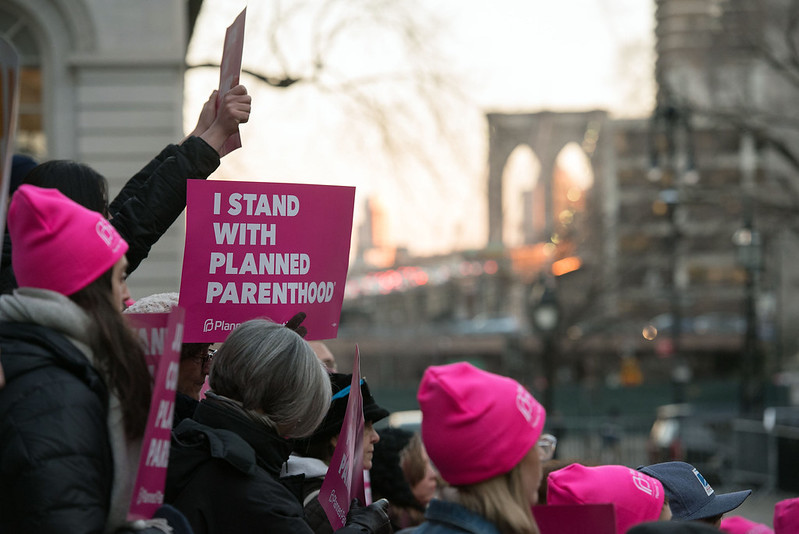
Planned Parenthood supporters (photo: Ed Reed/Mayoral Photography Office)
We are in a cultural and political moment of national reckoning with systemic racism and Planned Parenthood of Greater New York is not immune. We recently announced our decision to remove our founder Margaret Sanger’s name from our Manhattan Health Center and asked the City Council to remove a street sign named after her in the East Village.
Sanger was a champion of birth control — which expanded bodily autonomy for many, including women of color — and she also supported the racist ideology of eugenics. Both of those things are true. We must grapple with the totality of her legacy to allow our patients to access the full spectrum of sexual and reproductive health care free of fear, stigma, or shame from people who work in opposition of our mission.
Immediately following our announcement, anti-abortion agitators attempted to hijack the decision as a win of their own — they have weaponized Sanger’s complicated history in their crusade against reproductive freedom, particularly for black women. Their concern is fake and harmful. Women of color know that birth control, cancer screenings, HIV testing and treatment, wellness exams, and safe, legal abortion are essential to living a healthy life.
Many abortion opponents’ policies and politicians resist the advancement of Black, Latino, queer, trans, and gender-nonbinary people whose lives are deeply impacted by systemic racism, economic injustices, and health care inequality every day. They are not aligned with our belief that every person has the fundamental human right to bodily autonomy and the freedom to thrive. Instead, they exploit Sanger's name to block access to fundamental health care and health centers.
As PPGNY faces our past and reclaims our story, we expose them and their true intent of shaming tactics to stigmatize sexual and reproductive health care and reveal their deep disdain for women of color, Black women in particular, for daring to unapologetically assert control over our bodies, even after centuries of struggle.
Women of color have long understood the impact of Margaret Sanger’s support for eugenics. More than two decades ago Dr. Dorothy Roberts wrote in Killing the Black Body, “Birth control in America was defined from the movement’s inception in terms of race and could never be properly understood apart from race again.” The women of color who created and led the reproductive justice movement have given us a powerful blueprint to connect the dots and shape our work as a reproductive rights organization by understanding women of color ‘don’t live single-issue lives’ and systemic racism shapes every aspect of our lives, including sexual and reproductive health. We are learning, listening, and committing to following that collective wisdom as we work to transform our institution.
Our decision to reckon with our founder’s legacy extends far beyond renaming streets and buildings. It includes a public commitment to transforming the way we show up in and serve our communities. Our Reviving Radical initiative asks that we: 1) confront Planned Parenthood’s legacy and contributions to historical reproductive harm of communities of color; 2) divest from and dismantle white-dominant organizational cultural norms and values; 3) adopt individual and institutional practices that value people of color; 4) center communities of color’s voices, experiences, and knowledge of selves; and 5) build accountable relationships with communities of color.
These community mandates are fundamentally about undoing the racism woven into the fabric of every institution in this country and making the human right to bodily autonomy true for all. At Planned Parenthood of Greater New York, removing Sanger’s name was an important start but it is by no means the end of this conversation.
***
Merle McGee is Chief Equity and Engagement Officer at Planned Parenthood of Greater New York.
***
Have an op-ed idea or submission for Gotham Gazette? Email This email address is being protected from spambots. You need JavaScript enabled to view it.
Housing is Health, We Must Support It As Such — Especially Now
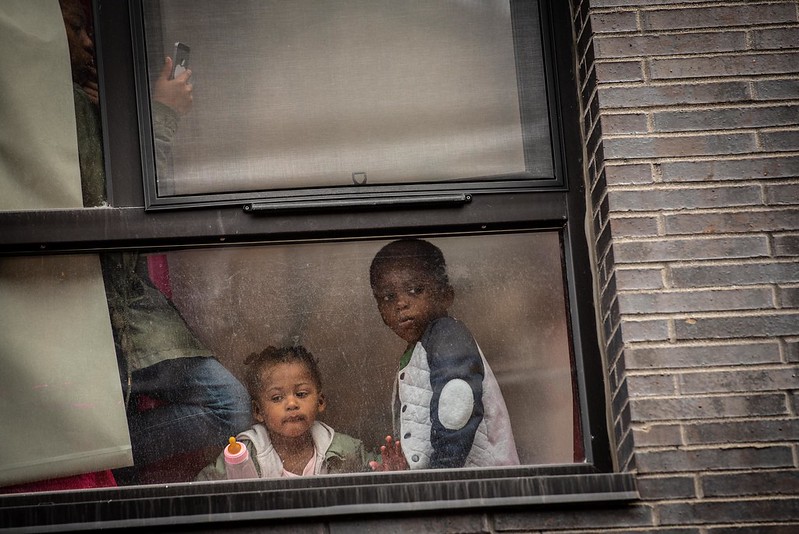
Health and housing are inextricably linked (photo: Michael Appleton/Mayor's Office)
The nationwide protests over the past few months are a response to the tragic murder of George Floyd by Minneapolis police officers -- and to the longstanding racial injustices plaguing our nation. Among these systemic crises is housing inequity and its impact on health.
Millions of people nationwide lack stable housing due to extremely high rent, domestic issues such as living with an abuser, or various other causes. In New York specifically, hundreds of thousands of low-income residents fall into this category, with a disproportionate number of these people being Black and Latino. In this time of COVID-19 when stable housing is more critical than ever, people of color are overwhelmingly suffering from the negative health impacts of not having a home.
We must now firmly address – and federally fund -- stable housing, as a crucial pillar of public health and racial justice. New York offers a clear example of why this is so important.
For the past 15 years, rent costs in New York have spiked upwards, eating up more and more of residents’ income. With millions of New Yorkers unemployed during the pandemic and the state eviction moratorium set to end in August, many New Yorkers face an imminent risk of losing their homes. Without comprehensive federal aid for state and local governments to preserve housing stability, we also risk eliminating much of the hard-won progress New York has made in the fight against COVID-19.
Housing & Health Links
Housing has always been foundational to human survival. It is at the base of Maslow’s Hierarchy of Needs, along with food, water, and warmth. Without a home, it’s that much harder to secure a quality education, job opportunities, and maintain good health. Being homeless undermines health through many pathways, including the increase in stress, exposure to the elements and other noxious agents, and need to spend time searching for shelter. In addition to those stressors, during this pandemic, homeless people are simply unable to “shelter in place” or work or learn “from home,” further jeopardizing their safety.
While many Americans and New Yorkers specifically were already homeless prior to the pandemic, more now face the threat of homelessness once eviction moratoria end. Those at risk, especially people who are Black and Latino, report great fear for their wellbeing. Black and Latino people already account for a disproportionately high number of COVID-19 deaths in the U.S., and the risk for contracting the virus escalates when people are forced to live on the streets, doubled up with other tenants, or in the overcrowded shelter systems.
The lack of housing options creates other crises. Amid stay-at-home orders, residents with abusive partners may face a higher risk of assault yet be unable to flee for safety. Cities across the country, including New York, have reported a recent increase in domestic violence cases, with those on the front lines reporting that abusers may intentionally expose their victims to the virus or threaten to kick them out if they test positive. To these residents, being quarantined with an abuser means inescapable trauma, adding to the stress and fear associated with the virus itself.
Solutions
How can we tackle these systemic injustices? Rental assistance is the first key solution, along with programs to connect renters in need with these resources. With New York’s state and city governments facing dire budget shortfalls, federal funding for rental assistance is urgently needed.
We urge Congress to direct $100 billion in supplemental appropriations to support substantial rental assistance, and also provide flexible funds to cover additional costs to housing providers including hazard pay for employees, extra cleanings, personal protective equipment, and more.
New York State has recently launched a rental assistance program using federal CARES Act funds to provide a one-time payment for residents with the greatest need, but far more aid is required to meet the growing needs of New Yorkers now. The federal government must expand aid to New York and other hard-hit states so that programs like these can be expanded and reach more people adversely impacted by the pandemic. This will help low-income people in New York and across America stay safe in their homes – and strengthen our continued collective efforts to mitigate COVID-19.
New York State recently passed the Emergency Rent Relief Act, which will direct $100 million from the federal CARES Act to be used towards rental assistance. We urge New York City and State to continue to prioritize funds they have already received through the CARES Act to support immediate rental assistance and other measures to keep New Yorkers safely housed.
Third, we need to ensure that federal aid for unemployed people continues throughout this prolonged shutdown period. The extra money to date has prevented many families from falling into poverty, enabling them to pay rent through this time of mass unemployment.
These critical measures are urgently needed to begin to combat the disastrous health disparities experienced by Black and Latino people. It’s also necessary to maintain the progress states like New York have made in slowing the infection rates of a disease that has taken an estimated 154,000 lives in America so far. We cannot continue to allow the pandemic’s disproportionate impact on people of color. We must proactively support efforts to provide stable housing for people most likely to experience health and housing inequities, through rental assistance, continued unemployment support, and other protective measures. As our nation acknowledges deeply rooted racial inequities, these meaningful measures to protect people who are housing insecure now are a crucial step towards true racial and economic justice.
***
Judi Kende is vice president and New York market leader of Enterprise Community Partners, a nonprofit housing organization. Dr. Mindy Fullilove is a social psychiatrist and professor of urban policy and health at The New School.
***
Have an op-ed idea or submission for Gotham Gazette? Email This email address is being protected from spambots. You need JavaScript enabled to view it.
Giving New York City’s 114,000 Homeless Children a Better Shot in School
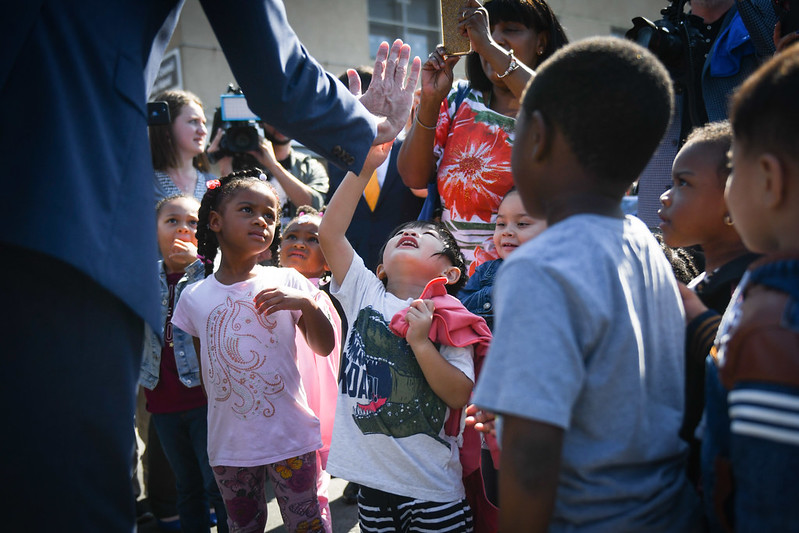
New York City school children (photo: Michael Appleton/Mayor's Office)
As thousands of demonstrators march through the streets of New York City calling for an end to police brutality and equality of opportunity for people of color, and we are on the verge of sending our children back to school of some kind, it is time that we focus on the most vulnerable people of color, and that is homeless children.
The organization Advocates For Children estimates that there are 114,000 homeless students in the New York City school system and that 85% are Black or Hispanic. This figure includes children not only living in shelters but also those that live doubled up with family or friends. These students perform significantly lower on state tests and only 57% graduate from high school, compared to 76% of all city students who are not homeless.
If we are going to make a difference in the way people of color are treated and accomplish economic security, it is essential that major efforts be put forward to lift these currently homeless children, improve their stations, and greatly increase their rate of high school graduation.
In the homeless shelter system we have approximately 11,000 families with children. On a relatively positive note this figure is down by 1,000 from the same time last year but still very high. However, we still have 20,000 children living in the shelter system. It is time we make a critical element of the evaluation of the work of the New York City Department of Homeless Services that children in their shelters and hotels show improved performance in school.
In order to understand the larger circumstances that these children and their parents live in, we must look at their environment. Typically a homeless family lives in a shelter unit or hotel room that is the equivalent of a small studio apartment. There are bunk beds for the kid(s) and a bed for the parent(s). Of homeless families, 80% are headed by a single adult female. There is a small kitchen area and a table and chairs to eat on and a bathroom. However, those families residing in hotels, at a cost of roughly $200 a night, often do not have a kitchen and depend on food deliveries three times a day.
Obviously, you can see the challenges of trying to do your schoolwork in such an environment. As a former Deputy Commissioner at the Department of Homeless Services and a senior executive at nonprofits that provide shelter and supportive housing for families, I know these circumstances all too well. It’s time that every shelter and hotel that houses homeless families be required to provide space for children to do their schoolwork. This could be accomplished in some cases, perhaps, by designating one study room for every four residential rooms.
Additionally, all homeless students should receive tutoring from a new program I am calling CUNY Students Supporting Homeless Children.
As a graduate of Brooklyn College and a New Yorker, I know that CUNY students could be extremely helpful to some of our most vulnerable students, and they could also earn some extra much-needed money. Children residing in the shelters, and those living doubled up, should also be given a laptop computer and provided with access to the internet so that they can access a wealth of important resources and also receive tutoring via Zoom as needed.
The nonprofit providers who run the shelters and the hotels would be given performance standards to ensure that their students are doing better in school and more are graduating high school. Failure to meet these standards could result in a cut to their contracts.
You may be thinking that this sounds great, but with looming budget cuts how are we going to pay for this program? We should create a public-private partnership with some of the more famous billionaires and philanthropists who live and work within our midst, like Jeff Bezos, Bill Gates, and former Mayor Michael Bloomberg who is well known for his interest in education and supporting important philanthropic causes. The goal should be to raise $1 billion to fund this campaign, including reaching out to the general public, members of which often care about our most vulnerable children but don’t always know how to help them. New Yorkers could get involved through a Go Fund Me-type page. It must be understood and guaranteed by New York City government that the monies raised through this initiative cannot be diverted to other programs.
Over 100,000 homeless children are now drowning, with far too many destined to fail given current conditions. While we also work to get them all safely housed, this initiative could provide them with a lifeboat to allow them to overcome their severe challenges, improve at and enjoy school, graduate, and have more opportunity.
***
Robert Mascali is former Deputy Commissioner to the New York City Department of Homeless Services and Vice President for Supportive Housing for Women in Need.
***
Have an op-ed idea or submission for Gotham Gazette? Email This email address is being protected from spambots. You need JavaScript enabled to view it.
Don’t Throw Out New York with the Police Reform
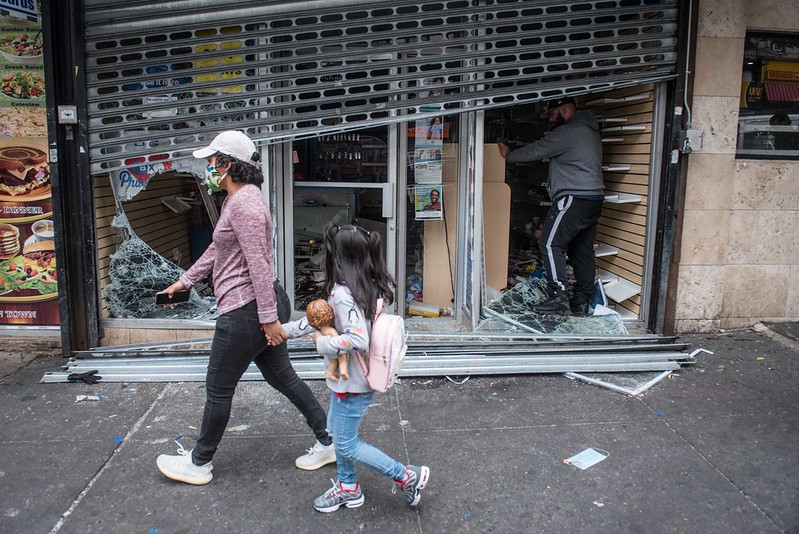
Aftermath of looting in the Bronx (photo: Michael Appleton/Mayor's Office)
Growing up near New York City in the 1970s and ‘80s, the city seemed a terrifying place, full of gangs, muggers, and tabloid-worthy murders.
By the time I moved to the city for work in the mid-’90s, however, it was in the midst of a transformation. The first two neighborhoods I lived in, in Manhattan, were Murray Hill and the East Village, and both initially had terrible reputations. Murray Hill featured street prostitutes and notorious single resident occupancy hotels, and the East Village was infamous for its “needle park” in Tompkins Square.
But the SROs became boutique hotels and the prostitutes became European tourists asking for directions. Tompkins Square Park evolved into a place for concerts and young families (mixed in with some needle users). The changes were emblematic of neighborhoods all over the five boroughs.
Why? It started with order and safety. Crime famously plummeted in New York through the 1990s and people living a more ordered life centered around work and the city’s cultural and nightlife followed. And the rebirth of New York as the nation’s economic and cultural capital has continued into the new century and over the last two decades.
But that incredible transformation is threatened today. Not just because of COVID-19, but also because of an overdue reform movement that is protesting publicly for a new paradigm in the relationship between public safety and order and the rights of people of color.
It is a movement full of the passion and talent found so often in New York’s young people. But those strengths are also a risk, of going too far and destroying the very place that helps bring that passion and talent to life.
It's time for the protesting to stop and the harder work of building the city back to begin.
I’m not some “law and order” ideologue who wants to see “rioters” put in their place. I’ve spent much of my professional career working in New York City during its transformation, for Democratic elected officials and candidates, and progressive policy issues.
But for New York to come back after COVID-19, white collar workers from the suburbs will have to return, residents will need to keep pushing the limits of livable neighborhoods, families will have to want to stay, and tourists will need confidence New York City remains vibrant and available.
None of this can happen without a city that feels safe and orderly. That doesn't just mean keeping crime low. It means not having graffiti-covered buildings and subways, protesters destroying property in very public ways, or nightly violent confrontations with police. And it means incorporating the movement’s reforms and leaders into the healthy civic infrastructure that exists in New York.
New York City has always been a place driven by young energy. The constant influx of bright, ambitious, and creative young people is the burning heart of “the city that never sleeps.” Ultimately the success or failure of New York City's future will come down to them.
This generation of young New Yorkers will have to decide what they want. Do they put their incredible drive behind a city that continues to thrive and grow, while it also confronts the need for public safety and public policy reform?
If so, this generation of young New Yorkers needs to work with elected officials, and the civic, business, and labor groups that have stayed committed to New York through thick and thin. And yes, they even have to partner with the police department itself to figure out how it can do the job of ensuring a safe city without unfair and unlawful targeting of people of color.
If not, it means expending that amazing energy on protesting alone. And that would be quite a waste.
***
Stephen Sigmund was Communications and Policy Director for the New York City Council and Chief of Public and Government Affairs for the Port Authority of NY/NJ. He is currently a public affairs consultant working on the Gateway rail program. On Twitter @ssiggy1.
***
Have an op-ed idea or submission for Gotham Gazette? Email This email address is being protected from spambots. You need JavaScript enabled to view it.
Ruling Paves Way for Massive Voting Rights Change to School Board Elections Across New York
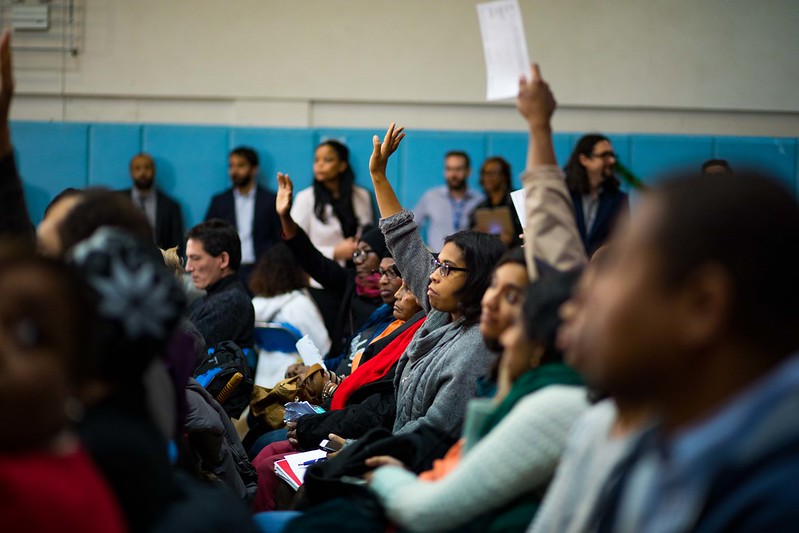
School Board elections may soon change across NY (photo: Benjamin Kanter/Mayoral Photo Office)
On May 25 in White Plains, U.S. District Court Judge Cathy Seibel ruled that the at-large system used for electing the nine members of the East Ramapo School Board denied the district’s Black and Latino voters effective choice in its elections, violating §2 of the Federal Voting Rights Act (VRA). Under an at-large system every voter votes to fill each board position, allowing a disciplined majority to control all seats. A majority of the East Ramapo district’s voting population is Hasidic Jews. The School Board has long been dominated by members recruited and endorsed by the leaders of this religious community and elected at-large through the use of block voting.
Children of Hasidic families in the district all attend private religious schools (Yeshivas) to which the board regularly diverts resources. Meanwhile the board’s tax cutting and repeated austerity budgets have starved the district’s public schools, where most of the students are members of minority groups. To redress this bias, Judge Seibel barred further at-large elections for the nine-member school board and ordered the immediate development of a ward-based plan for conducting future school elections. Under a ward system, board members are elected from geographically defined districts, permitting the election of members supported locally but not favored by the jurisdiction-wide majority.
The decision in this case, National Association for the Advancement of Colored People, Spring Valley Branch et. al. v. East Ramapo School District (17-CV-8943 (CS)), is historic for two reasons:
1. For the first time since the passage of the Voting Rights Act over a half-century ago, it has been used to require structuring choice in New York’s school board elections in a way known to be more responsive to minority communities. East Ramapo will become only the second of New York State’s 688 school districts to have ward-based elections. (The other is the City of Buffalo.)
2. Voting Rights Act litigation has previously been used to halt the use of at-large elections in New York municipalities, but until now the necessary evidence could not be marshalled to successfully challenge the practice in school districts. Judge Seibel relied heavily on expert political science testimony employing the statistical techniques of Ecological Inference and Bayesian Improved Surname Geocoding (BISG).
She wrote: “This may be the first time that voter-preference estimates based on BISG have been admitted into evidence at a VRA trial.” If sustained on appeal, this decision will provide the basis for change elsewhere, facilitating elections of members preferred by minority-community voters.
At-Large and Ward-Based Elections
New York law provides that all village, town, and school board elections be conducted at-large. As an alternative, towns and villages may adopt the use of wards by referendum. However, school districts may not.
The early 20th century progressive reformers who designed New York’s school governance system sought to “separate education from politics.” For them ward-based urban political machines were anathema. They wanted governance in the hands of “better men.” At-large elections were their primary tool for achieving this end.
These reformers were not shy about their unabashedly social and racial bias, as illustrated in the map and accompanying text below, taken from a 1916 book written by Dean and Professor Elwood Cubberly, cited by the New York State School Board Association as a framer of the New York system. Their preferred at-large system was discriminatory not only in its effect, but in its intent.
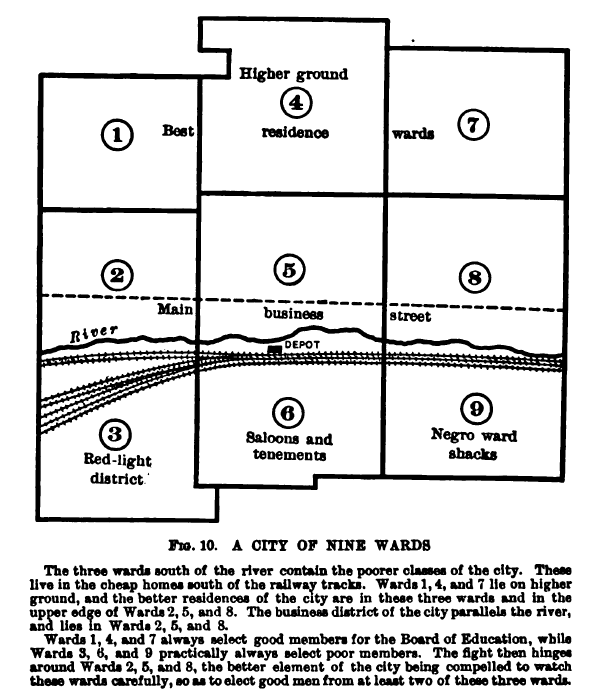
Evidence and Statistics
The discriminatory effect of at-large election was well-known by the time the Voting Rights Act was passed in 1965. The challenge was to prove it denied protected minorities effective choice in elections in specific cases to the satisfaction of federal judges. The courts required that members of these minorities seeking redress under the VRA show that the manner in which their jurisdiction’s election was structured systematically precluded them from having any impact on outcomes.
Voting is confidential. So is Census information. We do not keep individual level records about a person’s voting behavior or residence by race. Until now, therefore, proof of the invidious effect on minorities of the manner in which electoral choice is structured was built from a combination of place-specific voting records from their neighborhoods – aggregate election outcomes from Census blocks made up largely of minority group residents.
But in New York State, school board elections, unlike those for municipalities, are not conducted in geographically specified election districts. Aggregate place-specific records of voting by members of minority groups are therefore not available to combine with Census information to provide the needed proof of structural bias. Though VRA litigation has been successful in challenging the discriminatory effect of at-large elections for municipal elections in the state, conducted in geographically defined election districts, the impossibility of gathering needed evidence has heretofore blocked mounting similar litigation challenging the at-large structure of school board elections.
To overcome this barrier, lawyers for the NAACP brought in political scientists expert in Ecological Inference and BISG. Ecological Inference, pioneered by Gary King, a graduate of SUNY New Paltz and now a professor at Harvard, permits inferring individual behavior from group-level data. BISG combines individual level information about persons’ names with the place where they live to predict their race and/or ethnicity with high probability.
Much of Judge Seibel’s compelling 77-page opinion is devoted to a careful assessment of political scientists’ expert testimony and an explanation of why she finds it compelling in proving that the at-large system used in East Ramapo is in violation of the Voting Rights Act. As the case goes forward on appeal, however, it is cautionary to recall that the judge is functioning in a system headed by U.S. Supreme Court Chief Justice John Roberts, who in a redistricting case called political science expert testimony “sociological gobbledygook.”
Turnabout
Though they have long had the choice, only 14 of 932 New York State towns and 4 of 534 villages have opted for ward-based elections. But lately there has been a quickening of interest in this option in the Hudson Valley. The town of Blooming Grove switched over in 2016. Other municipalities have the matter under consideration. Special legislation has been introduced in Albany allowing the adoption of ward systems for the Chester Union Free School District, and the Washingtonville and Warwick Valley Central School Districts. General legislation has been entered by Hudson Valley state legislators to allow local choice of ward systems in Orange County and statewide. Ironically, in these jurisdictions, and increasingly in the wider region, the motivation seems not to assure effective choice by minority-group voters, but the protection of the control of schools by current majorities from a minority community growing rapidly in numbers and power – the Hasidic community – not protected under the Voting Rights Act.
***
Gerald Benjamin is Emeritus Founding Director of The Benjamin Center at SUNY New Paltz.
***
Have an op-ed idea or submission for Gotham Gazette? Email This email address is being protected from spambots. You need JavaScript enabled to view it.
A Housing Policy to Stimulate the New York Economy
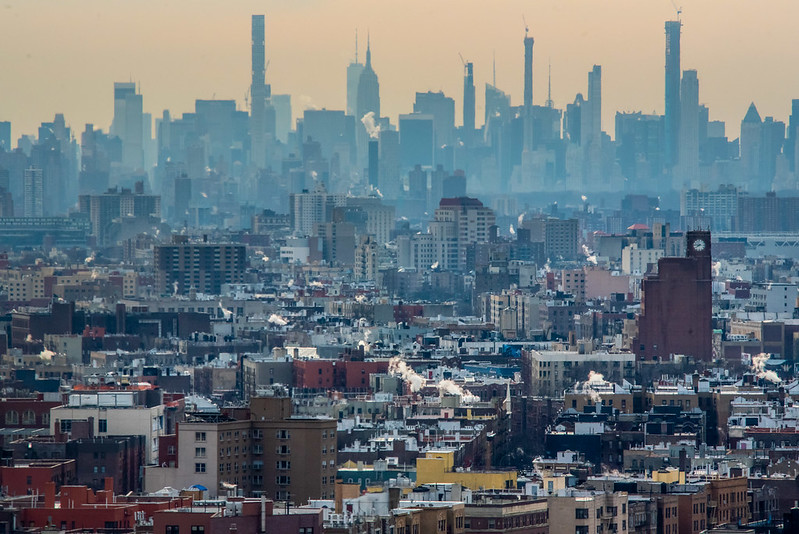
New York City (photo: Michael Appleton/Mayor's Office)
After months of being on pause and the ravages of COVID-19, we need to be thinking of ways to jumpstart our New York economy. Just as one can take a seemingly dead battery and revive it with the right charge and a set of jumper cables, we too can help to restart our economy with a charge of the right stimulus: changing the condo conversion laws to make condo conversion easier again.
Condo conversion refers to when a developer changes a rental residential building, typically owned by one landlord, to a condominium in which the units can be purchased by the current tenants or by “outside” buyers who did not live in the building before it became a condominium.
Prior to last summer, it was required that 15 percent of the units in a building had to be purchased by a combination of existing tenants or outside purchasers in order for a building to be converted to a condominium. In summer 2019, the law was changed to require 51 percent of tenants to purchase in order to convert buildings to condominiums. This increase has effectively resulted in stopping new conversions and the economic activity related to it, as well as the opportunity for tenants to purchase their units at a discounted price.
New York should once again permit condo conversions with 15% of units sold while adding in an affordable housing component.
This would help those in need of housing assistance, an especially dire need with New York unemployment at more than 20%. An affordable housing contribution from both developers and purchasers on initial and future closings would be a source of private funds to help support this important and critical public need.
This simple stimulus formula costs no infusion of cash from the public sector. To the contrary, it generates funds for the public sector in the form of city and state transfer taxes, income taxes, and filing fees, and most importantly at this time of high unemployment, it generates increased jobs thereby reducing unemployment and the cost of unemployment payments from the government.
Condo conversions not only help to stabilize neighborhoods and improve old housing stock, they create jobs and work for many types of businesses. In addition to development companies, they create work for contractors, electricians, plumbers, carpenters, security and building maintenance staff, architects and engineers, lawyers and accountants, advertising and public relations firms, advertising for newspapers, creative and web design firms, photographers, real estate brokers, mortgage brokers, lenders, title companies, furniture stores, lighting stores, decorators, appliance stores, hardware stores, and more.
Non-eviction condo conversion plans improve the living conditions of all building residents, whether they choose to purchase their apartment or not. In addition, tenants purchasing under condo conversion plans often secure their unit at a discount to the current market rate, and can typically obtain financing with lower down-payments, making home ownership more affordable.
In summary, simply amending the condo conversion laws with these proposed changes will create jobs, reduce unemployment, generate revenue for government, reduce governmental expenditure, generate private sector income, and help those in need of housing assistance. So, what are we waiting for? Now is the time to make this change and let a public-private partnership be a spark of needed energy in our recovery economy.
***
Roberta Axelrod is Director of Condo Conversions, Time Equities, Inc.
***
Have an op-ed idea or submission for Gotham Gazette? Email This email address is being protected from spambots. You need JavaScript enabled to view it.




